A Massive Green Tide in the Yellow Sea in 2021: Field Investigation and Analysis
Abstract
:1. Introduction
2. Materials and Methods
2.1. Cruise Data
2.1.1. Visual Observations
- Level 0: no floating patches.
- Level 1: patch area less than 5 m2.
- Level 2: patch area between 5 and 250 m2.
- Level 3: patch area between 250 and1000 m2.
- Level 4: patch area between 1000 and 25,000 m2.
- Level 5: patch area between 0.025 and 1 km2.
- Level 6: patch area greater than 1 km2.
2.1.2. Biomass Quantification
2.1.3. Species Identification
2.1.4. Nutrient Analysis
2.2. Remote Sensing Data
2.2.1. Floating Algal Index (Sentinel-3)
2.2.2. SST Data
2.3. Statistical Analysis
3. Results
3.1. Floating Macroalgal Distribution in Subei Shoal from Winter 2020 to Early Spring 2021
3.2. Floating Macroalgal Biomass in Subei Shoal in Spring 2021
3.3. Green Tide in the SYS in Late Spring and Summer 2021
3.4. Floating Macroalgae in the SYS in Summer 2021
3.5. Characteristics of Ulva Prolifera Green Tide in the SYS in 2021
3.6. Factors Influencing the Scale of the 2021 Green Tide in the SYS
4. Discussion
4.1. Analysis of the Causes of SYS Green Tide in 2021
4.2. Prevention Strategies and Recommendations to Control Green Tides in the SYS
5. Conclusions
Author Contributions
Funding
Institutional Review Board Statement
Data Availability Statement
Acknowledgments
Conflicts of Interest
References
- Yu, R.C.; Sun, S.; Yan, T.; Zhou, M.J. Progresses and perspectives on green-tide studies in the Yellow Sea. Oceanol. Limnol. Sin. 2018, 49, 942–949. [Google Scholar]
- Zhang, Y.; He, P.; Li, H.; Li, G.; Liu, J.; Jiao, F.; Zhang, J.; Huo, Y.; Shi, X.; Su, R.; et al. Ulva prolifera green-tide outbreaks and their environmental impact in the Yellow Sea, China. Natl. Sci. Rev. 2019, 6, 825–838. [Google Scholar] [CrossRef]
- Wang, C.; Yu, R.; Zhou, M. Acute toxicity of live and decomposing green alga Ulva (Enteromorpha) prolifera to abalone Haliotis discus hannai. Chin. J. Oceanol. Limnol. 2011, 29, 541–546. [Google Scholar] [CrossRef]
- Zhao, J.; Jiang, P.; Qin, S.; Liu, X.J.; Liu, Z.Y.; Lin, H.Z.; Li, F.H.; Chen, H.X.; Wu, C.H. Genetic analyses of floating Ulva prolifera in the Yellow Sea suggest a unique ecotype. Estuar. Coast. Shelf Sci. 2015, 163, 96–102. [Google Scholar] [CrossRef]
- Zhao, J.; Jiang, P.; Liu, Z.; Wang, J.; Cui, Y.; Qin, S. Genetic variation of Ulva (Enteromorpha) prolifera (Ulvales, Chlorophyta)—The causative species of the green tides in the Yellow Sea, China. J. Appl. Phycol. 2011, 23, 227–233. [Google Scholar] [CrossRef]
- Zhang, Q.C.; Yu, R.C.; Chen, Z.F.; Qiu, L.M.; Wang, Y.F.; Kong, F.Z.; Geng, H.X.; Zhao, Y.; Jiang, P.; Yan, T.; et al. Genetic evidence in tracking the origin of Ulva prolifera blooms in the Yellow Sea, China. Harmful Algae 2018, 78, 86–94. [Google Scholar] [CrossRef] [PubMed]
- Cui, J.; Monotilla, A.P.; Zhu, W.; Takano, Y.; Shimada, S.; Ichihara, K.; Matsui, T.; He, P.; Hiraoka, M. Taxonomic reassessment of Ulva prolifera (Ulvophyceae, Chlorophyta) based on specimens from the type locality and Yellow Sea green tides. Phycologia 2018, 57, 692–704. [Google Scholar] [CrossRef]
- Zhou, M.J.; Liu, D.Y.; Anderson, D.M.; Valiela, I. Introduction to the Special Issue on green tides in the Yellow Sea. Estuar. Coast. Shelf Sci. 2015, 163, 3–8. [Google Scholar] [CrossRef]
- Sun, S.; Wang, F.; Li, C.; Qin, S.; Zhou, M.; Ding, L.; Pang, S.; Duan, D.; Wang, G.; Yin, B.; et al. Emerging challenges: Massive green algae blooms in the Yellow Sea. Nat. Preced. 2008. [Google Scholar] [CrossRef]
- Hu, P.; Liu, Y.; Hou, Y.; Yin, Y. An early forecasting method for the drift path of green tides: A case study in the Yellow Sea, China. Int. J. Appl. Earth Obs. Geoinf. 2018, 71, 121–131. [Google Scholar] [CrossRef]
- Liu, X.; Li, Y.; Wang, Z.; Zhang, Q.; Cai, X. Cruise observation of Ulva prolifera bloom in the southern Yellow Sea, China. Estuar. Coast. Shelf Sci. 2015, 163, 17–22. [Google Scholar] [CrossRef]
- Yan, T.; Yu, R.C.; Zhou, M.J.; Sun, S. Mechanism of massive formation and prevention strategy against large-scale green tides in the South Yellow Sea. Oceanol. Limnol. Sin. 2018, 49, 950–958. [Google Scholar]
- Wang, Z.; Fu, M.; Zhou, J.; Shen, S.; Shao, K.; Hu, W.; Xiao, J.; Fan, S.; Zhang, X. Current situation of prevention and mitigation of the Yellow Sea green tide and proposing control measurements in the early stage. Haiyang Xuebao 2020, 42, 1–11. [Google Scholar]
- Wang, Y.; Liu, D.; Xiao, W.; Zhou, P.; Tian, C.; Zhang, C.; Du, J.; Guo, H.; Wang, B. Coastal eutrophication in China: Trend, sources, and ecological effects. Harmful Algae 2021, 107, 102058. [Google Scholar] [CrossRef] [PubMed]
- Ministry of Natural Resources (MNR). The Bulletin of China Marine Disaster; Ministry of Natural Resources of the People’s Republic of China: Beijing, China, 2020.
- Dingsør, G.E. Estimating abundance indices from the international 0-group fish survey in the Barents Sea. Fish. Res. 2005, 72, 205–218. [Google Scholar] [CrossRef]
- Zhao, J.; Jiang, P.; Li, N.; Wang, J.; Liu, Z.; Qin, S. Analysis of genetic variation within and among Ulva pertusa (Ulvaceae, Chlorophyta) populations using ISSR markers. Chin. Sci. Bull. 2010, 55, 705–711. [Google Scholar] [CrossRef]
- Leskinen, E.; Pamilo, P. Evolution of the ITS sequences of ribosomal DNA in Enteromorpha (Chlorophyceae). Hereditas 1997, 126, 17–23. [Google Scholar] [CrossRef]
- Tseng, C.K. Common Seaweeds of China; Science Press: Beijing, China, 1984; p. 316. [Google Scholar]
- Shimada, S.; Yokoyama, N.; Arai, S.; Hiraoka, M. Phylogeography of the genus Ulva (Ulvophyceae, Chlorophyta), with special reference to the Japanese freshwater and brackish taxa. In Proceedings of the 19th International Seaweed Symposium, Kobe, Japan, 26–31 March 2007; Borowitzka, M.A., Critchley, A.T., Kraan, S., Peters, A., Sjøtun, K., Notoya, M., Eds.; Springer: Dordrecht, The Netherlands, 2009. [Google Scholar]
- Wang, W.; Yu, Z.; Song, X.; Yuan, Y.; Wu, Z.; Zhou, P.; Cao, X. Intrusion Pattern of the Offshore Kuroshio Branch Current and Its Effects on Nutrient Contributions in the East China Sea. J. Geophys. Res. Ocean 2018, 123, 2116–2128. [Google Scholar] [CrossRef]
- Cummings, J.A.; Smedstad, O.M. Variational Data Assimilation for the Global Ocean. In Data Assimilation for Atmospheric, Oceanic and Hydrologic Applications; Park, S.K., Xu, L., Eds.; Springer: Berlin/Heidelberg, Germany, 2013; Volume II. [Google Scholar]
- Wang, B.; Wu, L. Numerical Study on the Massive Outbreak of the Ulva prolifera Green Tides in the Southwestern Yellow Sea in 2021. J. Mar. Sci. Eng. 2021, 9, 1167. [Google Scholar] [CrossRef]
- Xiao, J.; Zhang, X.; Gao, C.; Jiang, M.; Li, R.; Wang, Z.; Li, Y.; Fan, S.; Zhang, X. Effect of temperature, salinity and irradiance on growth and photosynthesis of Ulva prolifera. Acta Oceanol. Sin. 2016, 35, 114–121. [Google Scholar] [CrossRef]
- Zheng, L.; Wu, M.; Cui, Y.; Tian, L.; Yang, P.; Zhao, L.; Xue, M.; Liu, J. What causes the great green tide disaster in the South Yellow Sea of China in 2021? Ecol. Indic. 2022, 140, 108988. [Google Scholar] [CrossRef]
- Sun, S. The law, characteristics and impact of extreme weather and climate events in China. Disaster Reduct. China 2021, 15, 10–17. [Google Scholar]
- Xiao, J.; Fan, S.; Wang, Z.; Fu, M.; Song, H.; Wang, X.; Yuan, C.; Pang, M.; Miao, X.; Zhang, X. Decadal characteristics of the floating Ulva and Sargassum in the Subei Shoal, Yellow Sea. Acta Oceanol. Sin. 2020, 39, 1–10. [Google Scholar] [CrossRef]
- Li, D.; Gao, Z.; Wang, Z. Analysis of the reasons for the outbreak of Yellow Sea green tide in 2021 based on long-term multi-source data. Mar. Environ. Res. 2022, 178, 105649. [Google Scholar] [CrossRef]
- Cai, J.C.; Geng, H.X.; Kong, F.Z.; Zhang, Q.C.; Zhang, B.; Yan, T. Simulation Study on the Effect of Sargassum Horneri on other Harmful Bloom Causative Species. Oceanol. Limnol. Sin. 2019, 50, 1050–1058. [Google Scholar]
- Qi, L.; Hu, C.; Wang, M.; Shang, S.; Wilson, C. Floating algae blooms in the East China Sea. Geophys. Res. Lett. 2017, 44, 11501–11509. [Google Scholar] [CrossRef]
- Xiao, J.; Wang, Z.; Song, H.; Fan, S.; Yuan, C.; Fu, M.; Miao, X.; Zhang, X.; Su, R.; Hu, C. An anomalous bi-macroalgal bloom caused by Ulva and Sargassum seaweeds during spring to summer of 2017 in the western Yellow Sea, China. Harmful Algae 2020, 93, 101760. [Google Scholar] [CrossRef]
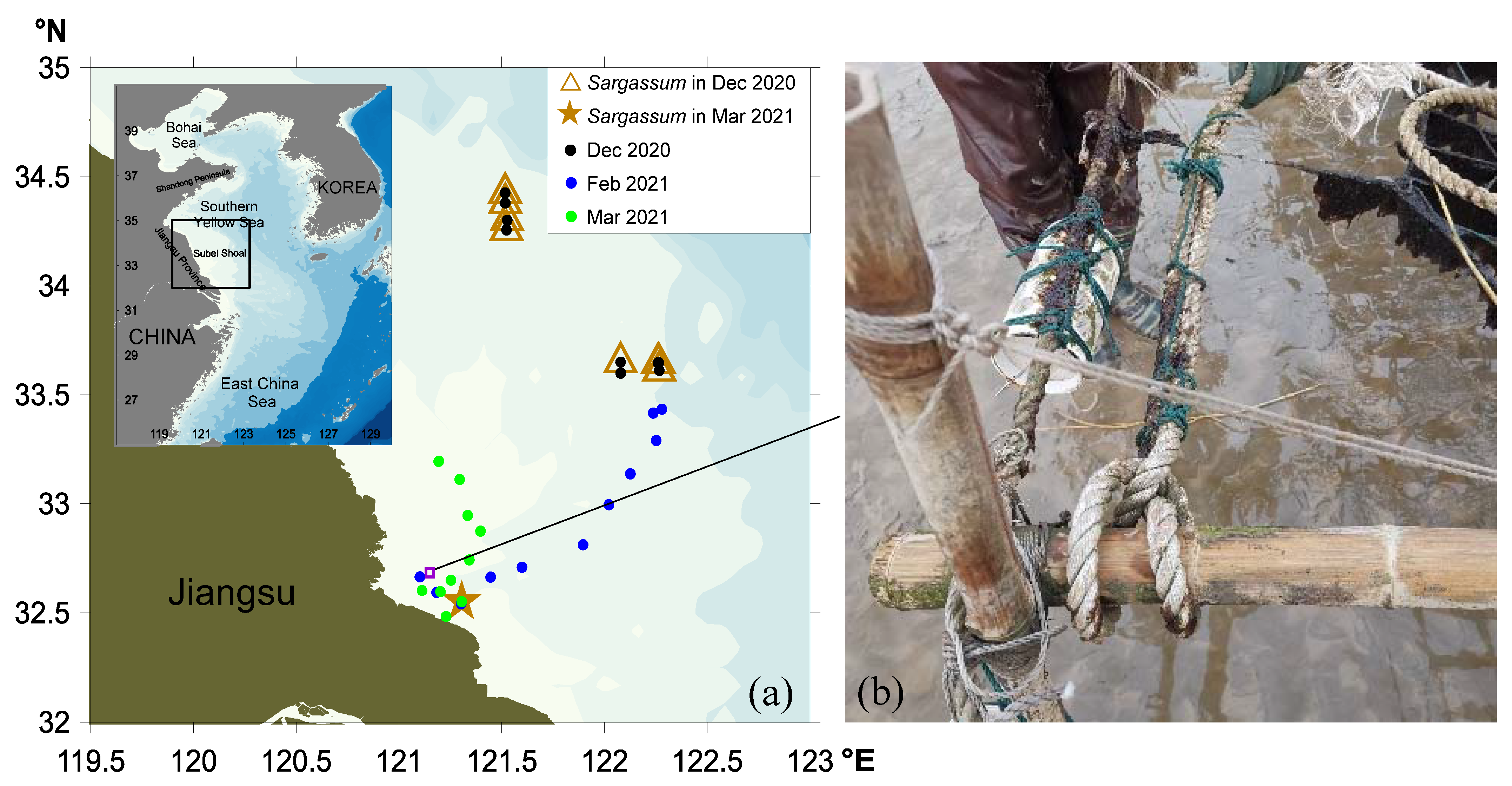
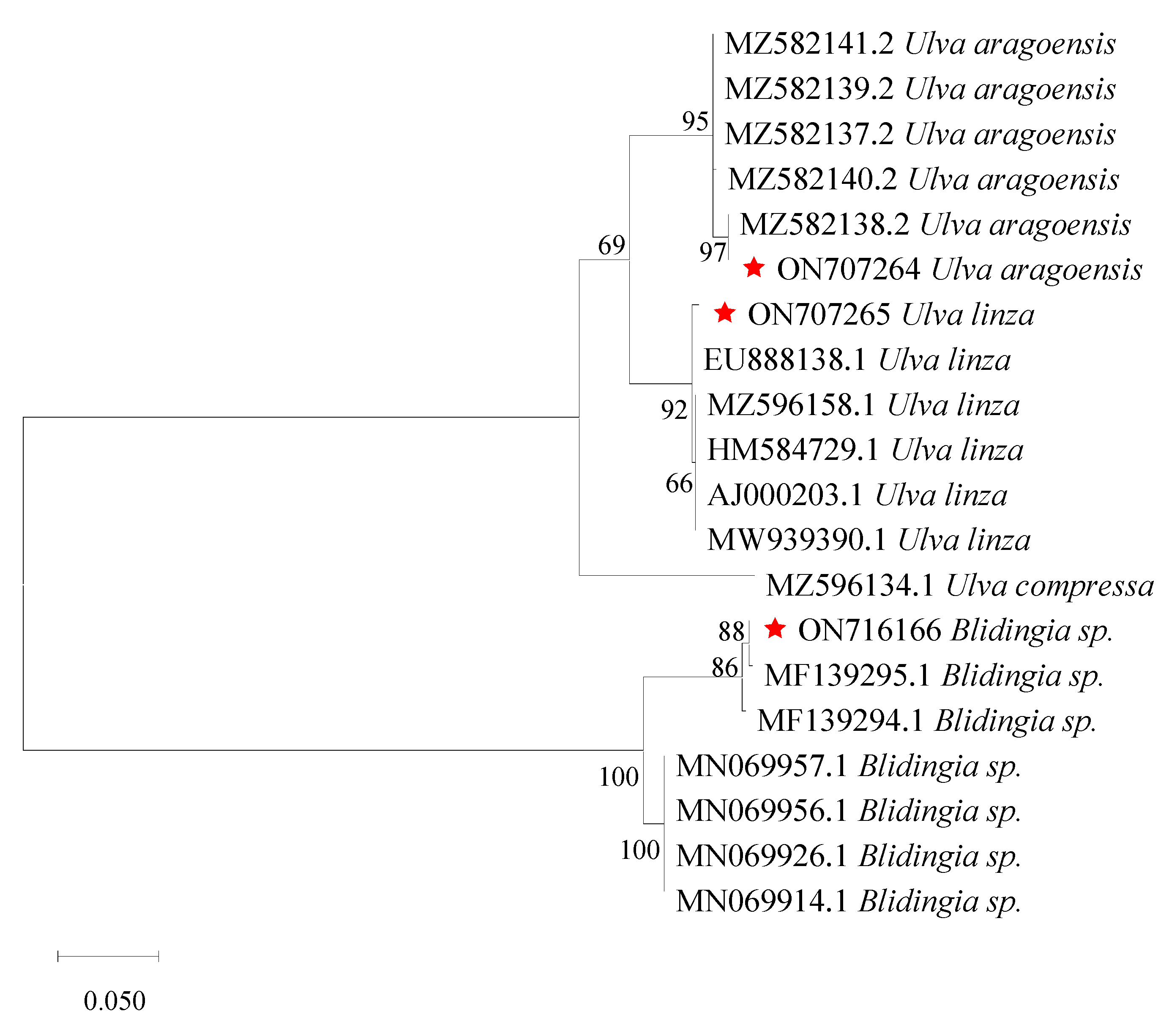
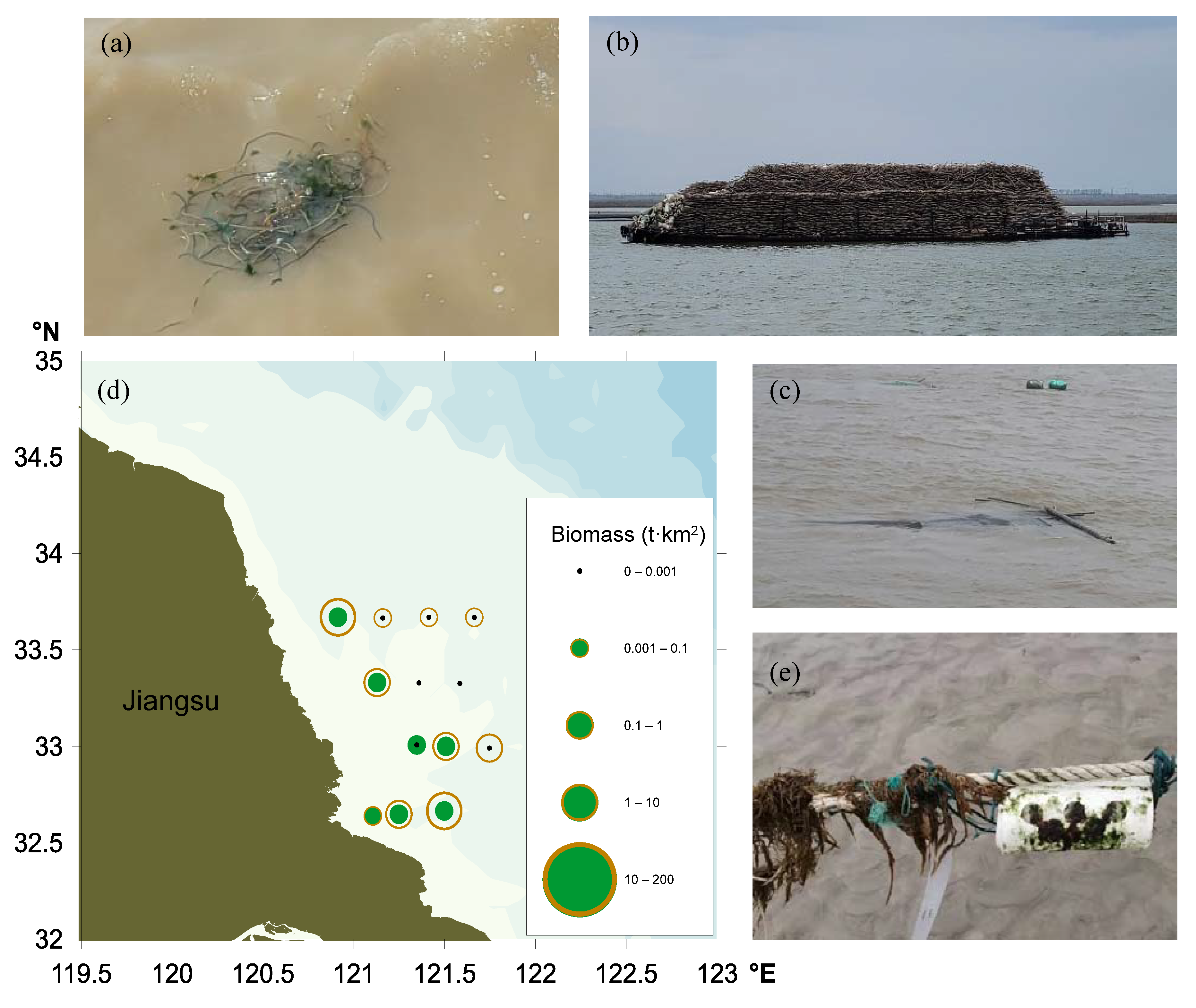
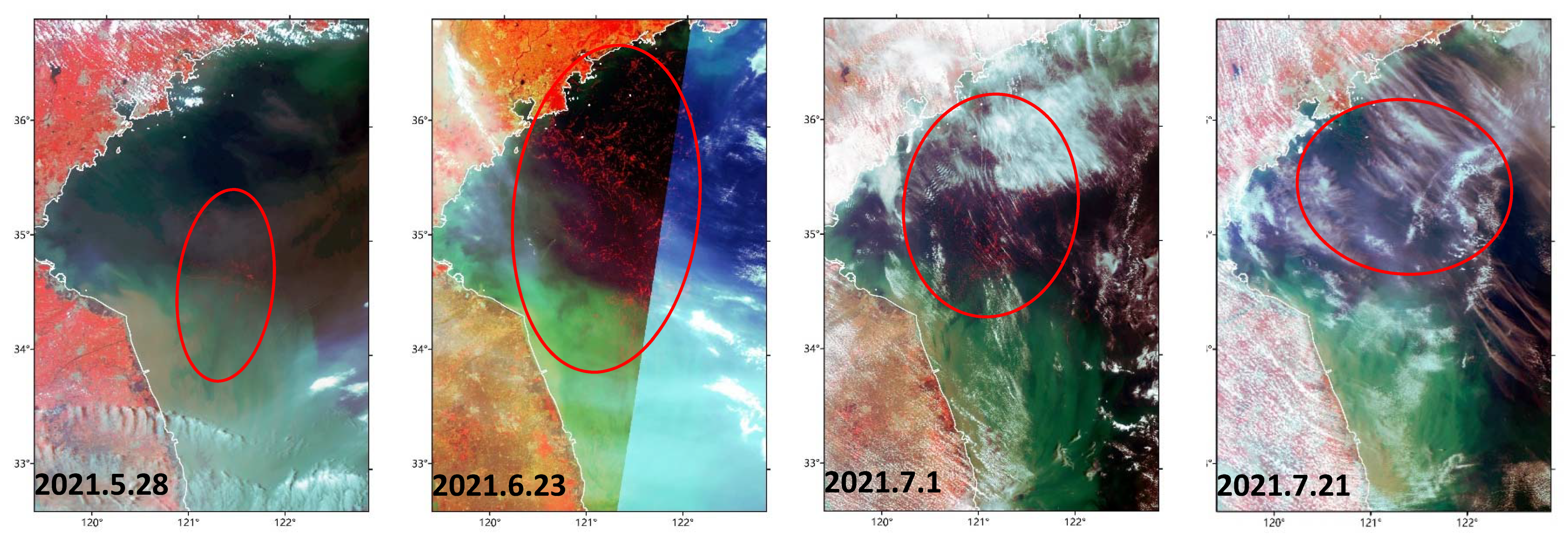

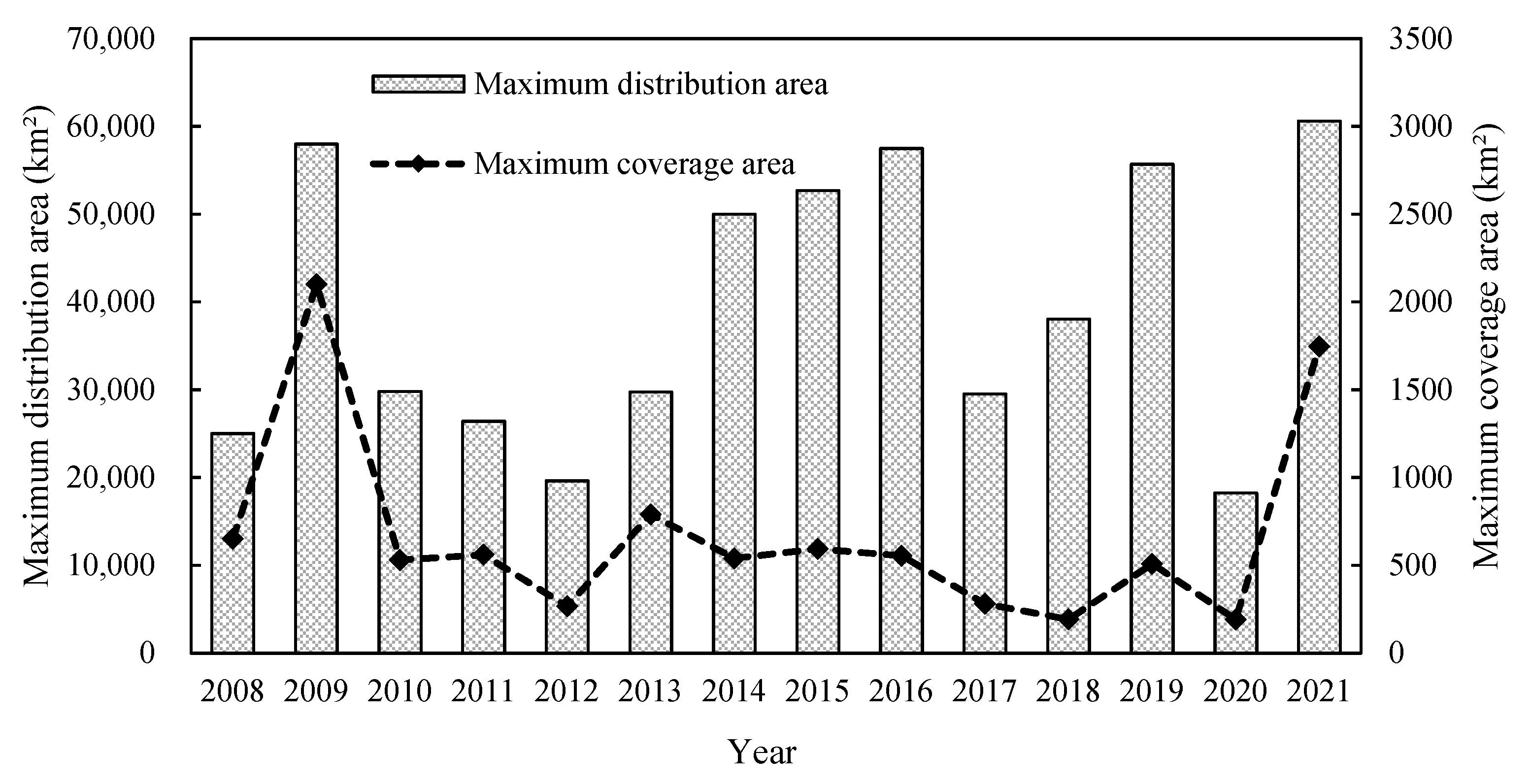



Publisher’s Note: MDPI stays neutral with regard to jurisdictional claims in published maps and institutional affiliations. |
© 2022 by the authors. Licensee MDPI, Basel, Switzerland. This article is an open access article distributed under the terms and conditions of the Creative Commons Attribution (CC BY) license (https://creativecommons.org/licenses/by/4.0/).
Share and Cite
Song, M.; Kong, F.; Li, Y.; Zhao, J.; Yu, R.; Zhou, M.; Jiang, P.; Yan, T. A Massive Green Tide in the Yellow Sea in 2021: Field Investigation and Analysis. Int. J. Environ. Res. Public Health 2022, 19, 11753. https://doi.org/10.3390/ijerph191811753
Song M, Kong F, Li Y, Zhao J, Yu R, Zhou M, Jiang P, Yan T. A Massive Green Tide in the Yellow Sea in 2021: Field Investigation and Analysis. International Journal of Environmental Research and Public Health. 2022; 19(18):11753. https://doi.org/10.3390/ijerph191811753
Chicago/Turabian StyleSong, Minjie, Fanzhou Kong, Yifan Li, Jin Zhao, Rencheng Yu, Mingjiang Zhou, Peng Jiang, and Tian Yan. 2022. "A Massive Green Tide in the Yellow Sea in 2021: Field Investigation and Analysis" International Journal of Environmental Research and Public Health 19, no. 18: 11753. https://doi.org/10.3390/ijerph191811753
APA StyleSong, M., Kong, F., Li, Y., Zhao, J., Yu, R., Zhou, M., Jiang, P., & Yan, T. (2022). A Massive Green Tide in the Yellow Sea in 2021: Field Investigation and Analysis. International Journal of Environmental Research and Public Health, 19(18), 11753. https://doi.org/10.3390/ijerph191811753





